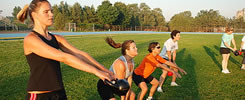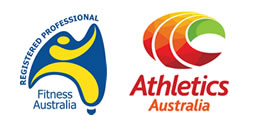The perfect running technique doesn’t exist, even the greats have their own anomalies. I think of Emil Zatopek’s anguished face or Haile Gebreslassie’s unique left arm drive. Their results were both outstanding so I’m not here to critique the great runners. We can however certainly improve our own technique and running efficiency and reap the rewards. Improved efficiency can translate into improved race times or reduced injury rates so it’s vital all runners continue to improve their technique.
1. Body position
Keep your head up over your shoulders and ‘run tall’. Allow your body to lean slightly forward, but remain upright. Do not bend at your hips or back, instead start your lean forward from your ankles, falling into your stride.
Maintain the slight forward lean throughout your body but be sure not to arch your back. Engage your core to keep a neutral spine. This is especially important running downhill or during sprint work. A fast cadence will help you take full advantage of the downhills.
Your arm drive will match your running stride, with the opposite arm driving forward as your knee lifts for the next stride. So keep your elbow bent at 90-degrees and relax your hands while maintaining a fluid arm action. Tense fists lead to tense shoulders, necks and wasted energy. Imagine you are holding a rice bubble between your finger & thumb, and stay relaxed in your arms. Drive forwards & back with your arms to help propel your legs (especially powering up those hills!). Sideways arm swings are inefficient so don’t let your arms cross the mid line of your body. When running at a fast pace aim to bring your hand up as high as your shoulder on your front arm while the elbow of your back arm drives back so your other hand is by your side.
2. Cadence
To maximise efficiency & minimise impact maintain a quick leg turnover. As mentioned above your arm drive plays an important role in helping you achieve an optimal cadence. Across all paces (fast & slow) a fast leg turnover will be beneficial. Count your current rate (in a minute) and compare. Many elites have a turnover or 180 steps/min (or 90 steps per leg/min) and for many coaches this is the ideal. If you are significantly lower (<160/min) gradually increase your cadence by 5-10% until it feels more natural. As with all development in running drastic sudden change isn’t ideal.
In long runs or training count your steps regularly to ensure you keep a quick turnover. Drills & speed work can be useful for improving the strength of your stride and maintaining your quick leg speed.
3. Strength
Glut & hip strength is essential for promoting strong technique, especially for longer runs. Without strong gluts your hips will sink lower on every stride resulting in longer ground contact times, slower leg turnover and higher incidence of leg injuries. Hip extensions (or bridges), clams, lunges and 1 leg squats are great ways to get the gluts firing & maximise your running form.
A relaxed natural feeling running technique that provides good running economy can be the best improvement you’ll make this summer. Follow these pointers above but remember the ‘perfect technique’ is slightly different for every runner depending on your anatomical strengths & weaknesses.



Speak Your Mind